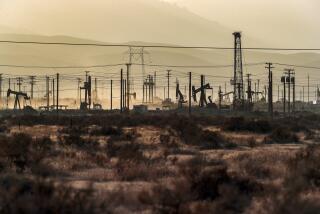Imperial Valley Project : SDG&E; Pins Hopes on Geothermal Plant
- Share via
HEBER — The $188.5-million electricity generating plant that San Diego Gas & Electric is helping to build outside this small desert town looks nothing like the nuclear, gas and coal-fired power plants that provide SDG&E; with its electric power.
With a preponderance of pumps and pipes and a futuristic control center, the Heber Binary Project looks and sounds more like a state-of-the art petroleum refinery.
But it is a power plant--one that transforms heat stored in geothermal deposits far below the Imperial Valley’s floor into electric power. The SDG&E; engineers who started up the demonstration project Friday expect the plant to one day provide enough electricity for some 45,000 customers.
Ten percent to 20% of SDG&E;’s electricity needs might one day be supplied by the kind of technology being tested here, according to project director Robert Lacy, who said there is enough geothermal energy worldwide to meet 5% of global electrical demand. He said the binary method being tested here could provide access to underground geothermal resources around the world.
While the binary technology is complex, the idea behind it is simple. Lacy said SDG&E; is tapping the same geothermal energy supply that the Romans and Greeks harnessed to warm their gymnasiums and that for generations has heated homes and businesses in Iceland.
Closer to home, in Northern California, utilities are using underground steam to spin electricity-generating turbines. Just a few hundred yards from the Heber Binary Project, a consortium led by Dravo Corp. is building a geothermal plant that uses a conventional geothermal power technology.
The Dravo plant’s geothermal system uses the “flash” process. It requires extremely hot geothermal reservoirs that, when pumped to the earth’s surface, flash into steam that powers a turbine that drives a generator to produce electricity.
Unfortunately, Lacy said, most of the Imperial Valley’s underground geothermal deposits are not hot enough to flash into steam after being extracted. Lacy said Heber’s binary technology extracts heat from lower-temperature brine (about 300 degrees to 500 degrees Fahrenheit) and transfers it to a second fluid that drives a turbine.
That takes place as the brine (salt- and mineral-saturated water) move through a heat exchanger. The second fluid, chosen because it vaporizes at a low temperature, drives the turbine. The cooled brine is then reinjected into the ground.
Proponents of the binary system say it has several major advantages over the flash method. Because the brine is reinjected, there are no emissions or wastes, which pleases environmentalists. And because the vaporized fluid is turning the turbine, the highly corrosive brine never comes in contact with the turbine.
A spokesman for the U.S. Department of Energy, which supplied 50% of Heber’s funding, said the project “is expected to illustrate by 1988 that the binary cycle is technically and economically ready to generate large-scale power from low- to moderate-temperature geothermal brine.”
But even if the technology proves cost-effective, there are some hitches in the development of geothermal power in the Imperial Valley and elsewhere in the world. Lacy pointed out that few geothermal sources are located near existing electric transmission lines. That problem, however, doesn’t exist for the Heber facility which is near SDG&E; power lines.
There is also a possibility that the flash and binary methods--which use water for cooling purposes--could conflict with future water demands, especially in arid climates. Lacy said the Heber plant, which uses a “paltry” amount of water compared to what farmers are using in the Imperial Valley, “presents no problems for the Imperial Irrigation District.”
SDG&E;, which supplies 31.3% of the funding for the Heber plant, will operate the plant as a demonstration project for two to three years. SDG&E; officials hope the plant will then continue producing 46 megawatts of power. Although SDG&E; will use most of the power generated by the plant, it must share the power generated with the state, the Imperial Irrigation District and Southern California Edison, each of which contributes to the project’s funding.
Leases for the geothermal deposits underneath the Imperial Valley floor are held by Union Oil and Chevron. The oil companies --listed by SDG&E; as “heat suppliers”--were first drawn to the Imperial Valley by the hope of discovering oil and gas. During the 1960s, “we hit water--hot water,” said Len Elliott, Chevron’s project manager. “So we got the leases converted” to cover the geothermal deposits.
Elliott said Chevron, which is drilling and maintaining the project’s brine wells, uses standard oil field technology.
“Drilling a hole is drilling a hole,” he said.
More to Read
Inside the business of entertainment
The Wide Shot brings you news, analysis and insights on everything from streaming wars to production — and what it all means for the future.
You may occasionally receive promotional content from the Los Angeles Times.








